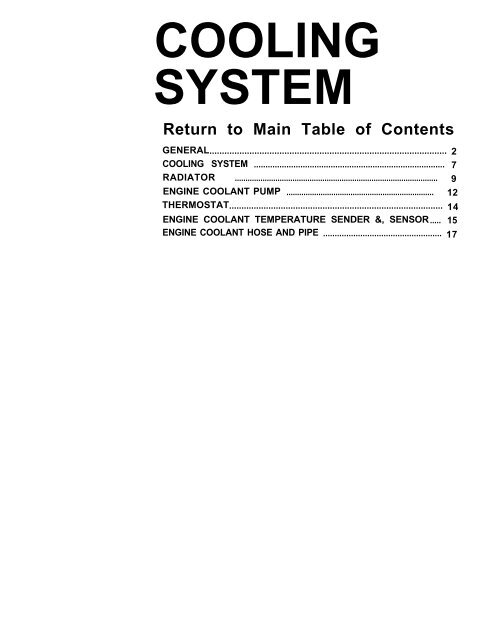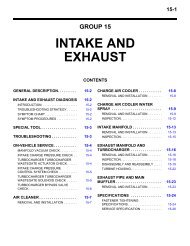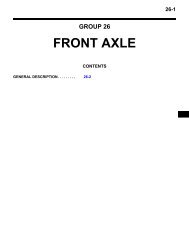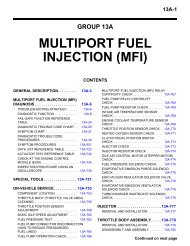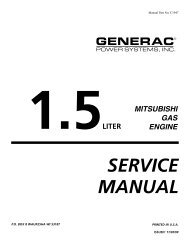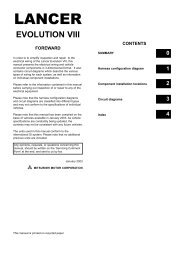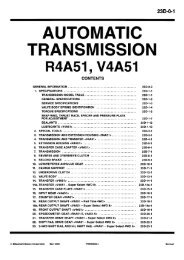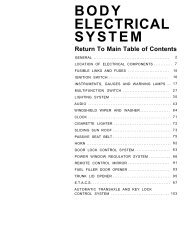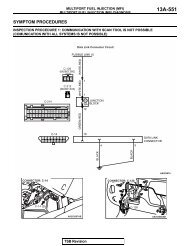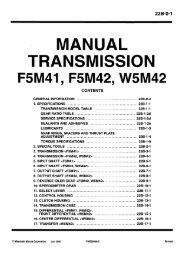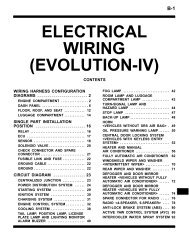Cooling System.pdf - LIL EVO
Cooling System.pdf - LIL EVO
Cooling System.pdf - LIL EVO
Create successful ePaper yourself
Turn your PDF publications into a flip-book with our unique Google optimized e-Paper software.
COOLING<br />
SYSTEM<br />
Return to Main Table of Contents<br />
GENERAL............................................................................................... 2<br />
COOLING SYSTEM .................................................................................. 7<br />
RADIATOR ............................................................................................... 9<br />
ENGINE COOLANT PUMP ..................................................................... 12<br />
THERMOSTAT....................................................................................... 14<br />
ENGINE COOLANT TEMPERATURE SENDER &, SENSOR..... 15<br />
ENGINE COOLANT HOSE AND PIPE ................................................... 17
25-2 GENERAL<br />
GENERAL<br />
SPECIFICATIONS<br />
<strong>Cooling</strong> method<br />
<strong>Cooling</strong> system<br />
Quantity<br />
Radiator cap<br />
Main valve opening pressure<br />
Vacuum valve opening pressure<br />
Engine coolant pump<br />
Thermostat<br />
Valve opening temperature<br />
Full-opening temperature<br />
Engine coolant temperature sender<br />
Resistance<br />
Thermo switch A (On radiator)<br />
Operating temperature<br />
Therm o switch A (On radiator)<br />
Operating temperature<br />
Therm o switch [On engine coolant outlet fitting]<br />
Operating temperature<br />
Engine coolant temperature sensor<br />
Resistance<br />
Water-cooled, pressurized.<br />
Forced circulation with electrical fan<br />
6 lit (6.3 U.S.qts., 5.2 Imp.qts.)<br />
74-103 kPa (10.7-14.9 psi, 0.75-1.05 kg/cm 2 )<br />
-6.86 kPa (-1.OO psi, -0.07 kg/cm 2 )or less<br />
Centrifugal type impeller<br />
88 o (190°F)<br />
100°C (212°F)<br />
90.5-117.5 4 at 70°C (158°F)<br />
21.3-26.34 at 115°C (239°F)<br />
[1.6 Eng.] [1.8 Eng.]<br />
85±3 o C (185±5.4 o F) 90±3 o C (194±5.4 o F)<br />
81±3 o C (177.8±5.4 o F) 83°C (191.4 o F) or more<br />
103°C (217.4 o F)<br />
110±3 o C (230±5.4 o F)<br />
105±3 o C (221±5 o F)<br />
98°C (208.4 o F) or more<br />
2.21-2.69 at 20°C (68°F)<br />
264-328 at 80°C (176°F)<br />
SERVICE STANDARD<br />
Standard value<br />
Coolant concentration<br />
50% [Except tropical areas]<br />
40% [Tropical areas]<br />
SEALANT<br />
Engine coolant temperature sender<br />
Engine coolant temperature sensor assy<br />
Three bond No.2310 or equivalent<br />
LOCTITE 962T or equivalent
GENERAL 25-3<br />
TIGHTENING TORQUE<br />
Generator support nut 20-25<br />
Generator adjuster lock bolt 12-15<br />
Engine coolant pump to cylinder block 12-15<br />
Engine coolant pump to cylinder block (generator brace mounting) 20-27<br />
Engine coolant pump pulley 8-10<br />
Engine coolant temperature sender 10-12<br />
Engine coolant temperature sensor 20-40<br />
Engine coolant outlet fitting bolt 17-20<br />
Nm<br />
kg.cm<br />
200-250<br />
120-150<br />
120-150<br />
200-270<br />
80-100<br />
100-120<br />
200-400<br />
170-200<br />
Ib.ft<br />
14-18<br />
9-11<br />
9-11<br />
14-20<br />
6-7<br />
7-9<br />
14-29<br />
12-14
25-4 GENERAL<br />
TROUBLESHOOTING<br />
Symptom<br />
Low coolant level<br />
Clogged radiator<br />
Abnormally high coolant<br />
temperature<br />
Abnormally low coolant<br />
temperature<br />
Leakage from oil cooling<br />
system<br />
Inoperative electrical<br />
cooling fan<br />
Probable cause<br />
Leakage of coolant<br />
Heater or radiator hose<br />
Faulty radiator cap<br />
Thermostat housing<br />
Radiator<br />
Engine coolant pump<br />
Foreign material in coolant<br />
Faulty thermostat<br />
Faulty radiator cap<br />
Restricted to flow in cooling system<br />
Loosen or missing drive belt<br />
Faulty engine coolant pump<br />
Faulty temperature sender or wiring<br />
Faulty electric fan<br />
Faulty thermo-switch in radiator<br />
lnsufficient coolant<br />
Faulty thermostat<br />
Faulty temperature sender or wiring<br />
Loose connections<br />
Cracked or damaged<br />
Hoses<br />
Pipes<br />
Oil cooler<br />
Damaged<br />
Thermo sensor<br />
Electrical motor<br />
Radiator fan relay<br />
Wiring<br />
Remedy<br />
Repair or replace parts<br />
Tighten or replace clamps<br />
Replace gasket or housing<br />
Replace<br />
Replace parts<br />
Replace coolant<br />
Replace parts<br />
Clear restriction or replace parts<br />
Adjust or replace<br />
Replace<br />
Repair or replace<br />
Repair or replace<br />
Replace<br />
Refill coolant<br />
Replace<br />
Repair or replace<br />
Tighten<br />
Replace<br />
Repair or replace
COOLANT LEAK CHECK<br />
1. Loosen the radiator cap.<br />
2. Confirm that the coolant level is up to the filler neck.<br />
3. Install a radiator cap tester to the radiator filler neck and<br />
apply 150 kPa (21 psi, 1.53 kg/cm 2 ) pressure. Hold for two<br />
minutes, while checking for leakage from the radiator, hose<br />
or connections.<br />
CAUTIONS<br />
1) Radiator coolant may be extremely hot. Do not open<br />
the system while hot, or scalding water could spray<br />
out causing personal injury. Allow vehicle to cool<br />
before servicing this system.<br />
2) Be sure to completely clean away any moisture from<br />
the places checked.<br />
3) When the tester is removed, be careful not to spill any<br />
coolant from it.<br />
4) Be careful, when installing and removing the tester<br />
and when testing, not to deform the filler neck of the<br />
radiator.<br />
4. If there is leakage, repair or replace the appropriate part.<br />
RADIATOR CAP PRESSURE TEST<br />
1. Use an adapter to attach the cap to the tester.<br />
2. Increase the pressure until the indicator of the gauge stops<br />
moving.<br />
Main valve opening pressure .............................<br />
81-108 kPa (11.8-15.6 psi, 0.83-1.10kg/cm 2 )<br />
Limit ........................... 65 kPa (9.2 psi, 0.66 kg/cm 2 )<br />
3. Check that the pressure level is maintained at or above the<br />
limit.<br />
4. Replace the radiator cap if the reading does not remain at or<br />
above the limit.<br />
NOTE<br />
Be sure that the cap is clean before testing, since rust<br />
or other foreign material on the cap seal will cause an<br />
improper indication.<br />
GENERAL 25-5<br />
SPECIFIC GRAVITY TEST<br />
1. Measure the specific gravity of the coolant with a hydrometer.<br />
2. Measure the coolant temperature, and calculate the concentration<br />
from the relation between the specific and temperature,<br />
using the following table for reference.
GENERAL<br />
RELATION BETWEEN COOLANT CONCENTRATION AND SPECIFIC GRAVITY<br />
Example<br />
The safe operating temperature is -15°C (5°F) when the measured specific gravity is 1.058 at coolant temperature of 20°C<br />
(68°F).<br />
CAUTION<br />
If the concentration of the coolant is below 30%, the anti-corrosion property will be adversely affected. In<br />
addition, if the concentration is above 60%, both the anti-freeze and engine cooling properties will decrease<br />
affecting the engine adversely. For these reasons, be sure to maintain the concentration level within the<br />
specified range.<br />
Do not use together with another brand.<br />
RECOMMENDED COOLANT<br />
Antifreeze<br />
ETHYLENE GLYCOL<br />
BASE FOR ALUMINUM<br />
Mixture ratio of anti-freeze in coolant<br />
Tropical area<br />
Other area<br />
40%<br />
50%
DRIVE BELT TENSION ADJUSTMENT<br />
The belt must be adjusted to the following specifications.<br />
1. When 100 N (22 lb) (tension or compression) is given perpen<br />
dicularly to belt at center “A”, sag is to be "L" mm.<br />
2. Or, tension gauge must read “T” at center “A”.<br />
COOLING SYSTEM 25-7<br />
Deflection<br />
Tension (T)<br />
New belt installed Used belt installed<br />
7.5 - 9.0 mm 10.0 mm<br />
(0.30-0.35 in.) (0.39 in.)<br />
50 - 70 kg 40 kg<br />
(110-154 lb) (88 lb)<br />
USAGE OF TENSION GAUGE<br />
Using Tension Gauge<br />
BORROUGHS BT-33-73F Type<br />
NIPPONDENS BTG-2 Type<br />
Measuring Method<br />
1. Press down on the tension gauge handle and insert the belt<br />
between the spindle and hook of the gauge.<br />
2. Release the handle and read the measurement on the gauge.<br />
NOTE<br />
1. Belt which had been in operation for 5 minutes or more,<br />
must be adjusted to the used belt specifications.<br />
2. Ensure that the belt is installed correctly, as shown in the<br />
illustration.<br />
3. A loose belt will produce a high-pitched squealing noise.<br />
4. A belt that is too is tight will damage the generator and<br />
engine coolant pump bearings.
25-8 COOLING SYSTEM<br />
DRIVE BELT AND PULLEY<br />
Removal<br />
1. Loosen generator support nut “A” and the belt tension adjuster<br />
lock bolt “B”.<br />
2. Rotate the adjuster bolt counterclockwise to relieve belt tension,<br />
and remove the belt.<br />
3. Remove the water pump pulley bolts and remove the engine<br />
coolant pump pulley.<br />
Tightening torque<br />
Generator support nut A ...................................<br />
20-25 Nm (200-250 kg.cm, 14-18 Ib.ft)<br />
Adjuster lock bolt B ..........................................<br />
12-15 Nm (120-150 kg.cm, 9-11 Ib.ft)<br />
Inspection<br />
Check the following items and replace if defective.<br />
1. Check the surface for damage, peeling or cracks.<br />
2. Check the belt surface for oil or grease.<br />
3. Check the rubber for worn or hardened areas.<br />
4. Check the surface of the pulley for cracks or damage.<br />
Installation<br />
1. Install the engine coolant pump pulley to the engine coolant<br />
pump pulley bracket and tighten the bolts firmly.<br />
2. After installing the belt, adjust the belt tension. See “DRIVE<br />
BELT TENSION DEFLECTION CHECK AND ADJUSTMENT”.<br />
CAUTION<br />
Note that 1.6L and 1.8L Engine V-ribbed velts are different<br />
in length.<br />
Standard value<br />
1.6L Engine .................................................. 980±5 mm<br />
1.8L Engine ..................................................... 990±5 mm
RADIATOR 25-9<br />
RADIATOR<br />
COMPONENTS
25-10 RADIATOR<br />
REMOVAL<br />
1. Disconnect the fan motor plug.<br />
2. Set the warm engine coolant flow control knob of the heater<br />
control to the hot position.<br />
3. Loosen the radiator drain plug to drain coolant.<br />
4. Disconnect the upper and lower hose, and the overflow tube.<br />
5. For vehicles with an automatic transaxle, disconnect the oil<br />
cooler hoses from the automatic transaxle.<br />
CAUTION<br />
Plug the ends of the oil cooler hoses and the automatic<br />
transaxle port to prevent the transaxle fluid from spilling<br />
out and foreign material from getting in.<br />
6. Remove the radiator mounting bolts.<br />
7. Remove the radiator together with the fan motor.<br />
8. Remove the fan motor from the radiator.<br />
INSPECTION<br />
1. Check the radiator for bent, broken, or plugged fins.<br />
2. Check the radiator for corrosion, damage, rust or scale.<br />
3. Check the radiator hoses for cracks, damage or deterioration.<br />
4. Check the reservoir tank for damage.<br />
5. Check the radiator cap spring for damage. Pressure test the cap<br />
using a cooling system checker.<br />
6. Check the radiator cap seal for cracks or damage.<br />
7. Check for continuity with the thermo switch in hot water.<br />
Continuity at 85 ± 3°C (185 ± 5.4 o F) [1.6L Eng.]<br />
90 ± 3°C (194±5.4 o F) [1.8L Eng.]<br />
No continuity at 81±3°C (178 ±5.4 o F) [1.6L Eng.]<br />
83°C (181.4 o F) or more [1.8L Eng.]<br />
NOTE<br />
Immerse the thermo switch in hot engine coolant up to the<br />
mounting threads to check for continuity.<br />
8. Check for continuity with thermo switch B in hot engine coolant<br />
Continuity at 103°C (217.4 o F)<br />
No continuity at 110 o C±3 o C (230±5.4 o F) or more
9. Check for continuity with thermo sensor on water outlet fitting in<br />
hot water.<br />
Continuity at 102-108°C (215.6-226.4 o F)<br />
No continuity at 98°C (208.4 o F) or more<br />
RADIATOR 25-11<br />
Radiator Fan Motor<br />
1. Check to be sure that the radiator fan rotates when battery<br />
voltage is applied between the terminals (as shown in the<br />
figure).<br />
2. Check to see that abnormal noises are not produced while the<br />
motor is turning.<br />
INSTALLATION<br />
1. Fill the radiator and reservoir tank with a fresh coolant mixture.<br />
2. Run the engine until the coolant has warmed up enough so that<br />
the thermostat valve opens, and then stop the engine.<br />
3. Remove the radiator cap, pour in the coolant until it is up to the<br />
filler neck of the radiator, and then fill the reservoir tank to the<br />
upper level.<br />
4. Check to be sure that there is no leakage from the radiator,<br />
hoses or connections.
25-12 ENGINE COOLANT PUMP<br />
ENGINE COOLANT PUMP<br />
COMPONENTS<br />
TORQUE : Nm (kg.cm, Ib.ft)
REMOVAL<br />
1. Drain the coolant and disconnect the radiator outlet hose and<br />
engine coolant by-pass hose from the engine coolant pump.<br />
2. Remove the drive belt and engine coolant pump pulley.<br />
3. Remove the timing belt covers and the timing belt tensioner.<br />
4. Remove the engine coolant pump mounting bolts and then<br />
remove the generator brace.<br />
5. Remove the engine coolant pump assembly from the cylinder<br />
block.<br />
ENGINE COOLANT PUMP 25-13<br />
INSPECTION<br />
1. Check the engine coolant pump for cracks, damage or wear,<br />
and replace the engine coolant pump assembly if necessary.<br />
2. Check the bearing for damage, abnormal noise and sluggish<br />
rotation, and replace the engine coolant pump assembly if<br />
necessary.<br />
3. Check the seal unit for leaks, and replace the engine coolant<br />
pump assembly if necessary.<br />
4. Check for water leakage. If water leaks from hole “A”, seal unit<br />
is defective. Replace engine coolant pump assembly.<br />
INSTALLATION<br />
1. Clean the gasket surfaces of the engine coolant pump body and<br />
the cylinder block.<br />
2. Install the new O-ring onto the groove on the front end of the<br />
engine coolant pipe, then wet the O-ring with water. Do not apply<br />
oil or grease.<br />
3. Install a new engine coolant pump gasket and engine coolant<br />
pump assembly. Tighten the bolts to the specified torque.<br />
Tightening torque<br />
Engine coolant pump to cylinder block<br />
Head mark “4” bolt ......................................<br />
12-15 Nm (120-150 kg.cm, 9-11 Ib.ft)<br />
Head mark “7” bolt ...............................<br />
20-27 Nm (200-270 kg.cm, 14-20 Ib.ft)<br />
4. Install the timing belt tensioner and timing belt. Adjust the timing<br />
belt tension, and then install the timing belt covers.<br />
5. Install the engine coolant pump pulley and drive belt, and then<br />
adjust the belt tension.<br />
6. Refill the coolant.<br />
7. Run the engine and check for leaks.
25-14 THERMOSTAT<br />
THERMOSTAT<br />
TORQUE :<br />
Nm (kg.cm, Ib.ft)<br />
REMOVAL AND INSPECTION<br />
1. Drain the coolant down to thermostat level or below.<br />
2. Remove the water outlet fitting and gasket.<br />
3. Remove the thermostat.<br />
4. Heat the thermostat as shown in the illustration.<br />
5. Check to see if the valve operates properly.<br />
6. Check to determine the temperature at which the valve begins<br />
to open.<br />
Valve opening temperature ..................................... 88 o C(190 o F)<br />
Full opening temperature ......................................... 1OO o C(212 o F)<br />
Valve lift (at full open) .................................. 8mm (0.31in.) or more<br />
INSTALLATION<br />
1. Check to ensure that the flange of the thermostat is correctly<br />
seated in the socket of the thermostat housing. If the thermostat<br />
is installed in the wrong direction, the bottom of the thermostat<br />
will touch the rib inside the intake manifold, making it impossible<br />
to seat the flange in position.<br />
2. Install a new gasket and water outlet fitting.<br />
3. Refill the coolant.
ENGINE COOLANT TEMPERATURE SENDER, SENSOR<br />
ENGINE COOLANT TEMPERATURE SENDER, SENSOR<br />
COMPONENTS<br />
TORQUE : Nm (kg.cm, Ib.ft)<br />
REMOVAL<br />
1. Drain the coolant down to sender level or below.<br />
2. Disconnect the battery ground cable and disconnect the engine<br />
harness.<br />
3. Remove the engine coolant temperature sender and sensor.<br />
INSPECTION<br />
1. Heat the engine coolant temperature sender by submerging it<br />
in hot water.<br />
2. Check that the resistance is within the specified range.<br />
Resistance .......................... 90.5-117.5 at 70°C (158°F)<br />
21.3-26.3 at 115°C (239°F)
25-16 ENGINE COOLANT TEMPERATURE SENDER, SENSOR<br />
Engine Coolant Temperature Sensor<br />
1. Heat the sensor by submerging it in hot water.<br />
2. Check that the resistance is within the specified range.<br />
Resistance ...................... 2.21-2.69 at 20°C (68°F)<br />
264-328 at 80°C (176°F)<br />
INSTALLATION<br />
1. Apply sealant to the threaded portion and tighten to the<br />
specified torque.<br />
Engine coolant temperature sender ............................<br />
Three bond NO.2310 or equivalent<br />
Engine coolant temperature sensor .................................<br />
LOC TITE 962T or equivalent<br />
Tightening torque<br />
Engine coolant temperature sender .............................<br />
10-12 Nm (100-120 kg.cm, 7-9 Ib.ft)<br />
Engine coolant temperature sensor ........................<br />
20-40 Nm (200-400 kg.cm, 14-29 Ib.ft)<br />
2. Connect the harness to the engine coolant temperature sender,<br />
temperature sensor.<br />
3. Connect the battery ground cable.<br />
4. Refill with coolant.
ENGINE COOLANT HOSE AND PIPE<br />
COMPONENTS<br />
ENGINE COOLANT HOSE AND PIPE 25-17<br />
TORQUE : Nm (kg.cm, Ib.ft)<br />
INSPECTION<br />
Check the engine coolant pipe and hose for cracks, damage, or<br />
restrictions. Replace if necessary.<br />
INSTALLATION<br />
Fit O-ring in the groove provided at engine coolant inlet pipe end,<br />
wet the periphery of O-ring and inset engine coolant inlet pipe.<br />
NOTE<br />
1. Do not apply oils or greases to water pipe O-ring.<br />
2. Keep the engine coolant pipe connections free of sand,<br />
dust, etc.<br />
3. Insert engine coolant pipe until its end bottoms.


